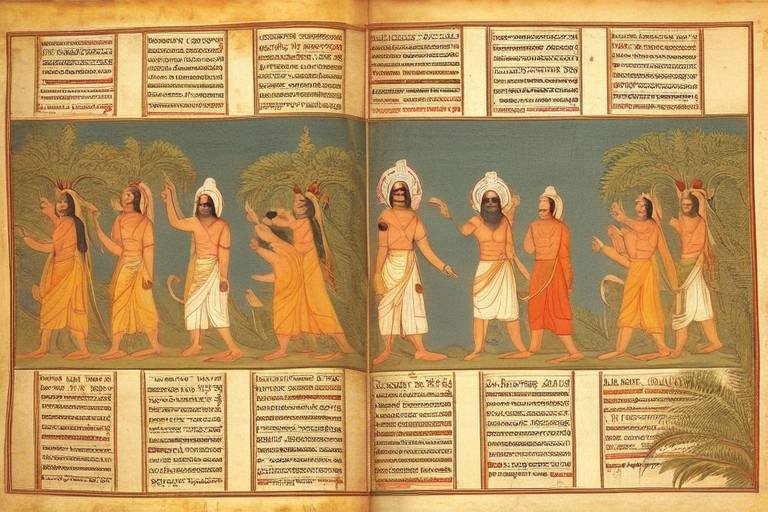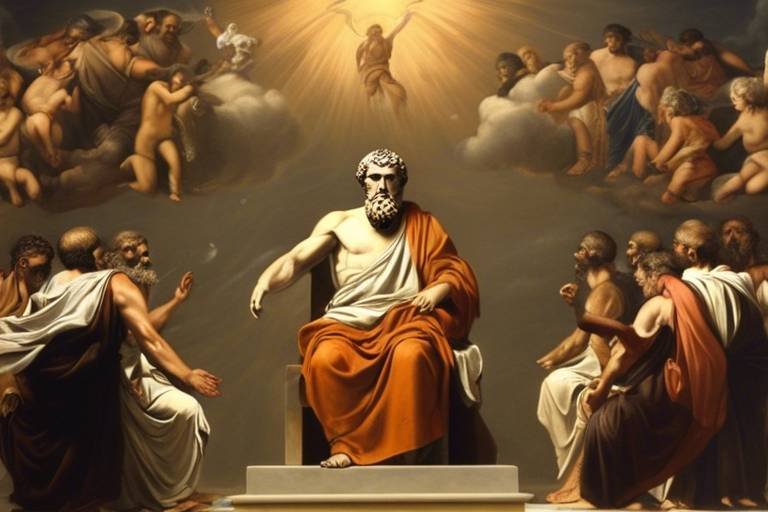Philosophy in Ancient Indian Scriptures - Rigveda and Upanishads
The exploration of philosophy in ancient Indian scriptures, particularly the Rigveda and the Upanishads, is like embarking on a journey through a vast landscape of thought and spirituality. These texts, which date back thousands of years, are not merely historical documents; they are the bedrock of Indian philosophy, influencing countless generations in their quest for understanding the universe and their place within it. Imagine standing at the edge of a great ocean, where each wave represents a different idea, a unique perspective on existence. The Rigveda and Upanishads are those waves, each contributing to the rich tapestry of Indian thought, inviting us to dive deeper into the waters of wisdom.
As we delve into the Rigveda, we encounter hymns that resonate with the echoes of ancient voices, speaking of the cosmos, the divine, and the essence of life itself. This scripture serves as a foundational text in Hindu philosophy, laying the groundwork for subsequent philosophical inquiry. The Upanishads, on the other hand, take us further into the realm of metaphysics, encouraging us to ponder the profound relationship between the individual self and the universal spirit. Together, these texts create a dialogue that spans centuries, continually inviting reflection and interpretation.
To truly appreciate the significance of these scriptures, we must recognize their role in shaping not only religious practices but also ethical frameworks and philosophical discourse in India. The teachings found within the Rigveda and Upanishads have been a source of inspiration for thinkers, sages, and spiritual seekers alike. They challenge us to question our understanding of reality and to seek a deeper connection with the divine. In a world that often feels chaotic and disconnected, the wisdom of these ancient texts offers a guiding light, illuminating the path toward self-discovery and spiritual fulfillment.
As we journey through the philosophies embedded in these scriptures, we will uncover essential themes such as dharma, the nature of the divine, and the quest for self-realization. Each theme serves as a stepping stone, leading us closer to the ultimate truths that have captivated human thought for millennia. So, let’s embark on this enlightening exploration, diving into the depths of ancient wisdom and emerging with insights that resonate even in our modern lives.
- What is the Rigveda?
The Rigveda is one of the oldest sacred texts of Hinduism, consisting of hymns that explore various aspects of life, spirituality, and the cosmos.
- What are the Upanishads?
The Upanishads are a collection of philosophical texts that delve into the nature of reality, the self, and the ultimate truth known as Brahman.
- How do the Rigveda and Upanishads differ?
While the Rigveda focuses on hymns and rituals, the Upanishads explore deeper metaphysical concepts and the relationship between the self and the universe.
- What is the significance of dharma in the Rigveda?
Dharma, or righteousness, is a central theme in the Rigveda, emphasizing the importance of ethical living and moral duties within society.

The Rigveda: An Overview
The Rigveda, often hailed as one of the oldest known texts in human history, is a remarkable collection of hymns that holds a pivotal place in the foundations of Hindu philosophy. Composed in ancient Sanskrit, this sacred scripture not only serves as a spiritual guide but also reflects the early cosmological and existential inquiries of humanity. Imagine stepping into a time machine and landing in the heart of ancient India, where the very essence of life was being contemplated through poetic verses. That’s the essence of the Rigveda—an exploration of the cosmos, the divine, and the intricate tapestry of existence.
Within its verses, the Rigveda encapsulates a rich tapestry of themes that resonate with the human experience. It is a treasure trove of spiritual wisdom, containing hymns dedicated to various deities, each representing different aspects of life and nature. These hymns are not just mere expressions of devotion; they are profound reflections on the relationship between humanity and the cosmos. The Rigveda invites us to ponder questions like, "What is the nature of reality?" and "How do we connect with the divine?"
As we delve deeper, we find that the Rigveda is structured into ten books, known as mandalas, each containing numerous hymns that explore various facets of existence. These hymns can be seen as the earliest attempts to articulate the complexities of life, morality, and the universe. For instance, the recurring themes of creation, sacrifice, and the cosmic order (Rta) are prevalent throughout the text, showcasing the ancient Indian worldview.
| Mandalas | Description |
|---|---|
| 1 | Hymns dedicated to Agni, the fire god, emphasizing the importance of fire in rituals. |
| 2 | Hymns focusing on the aspects of creation and the divine order. |
| 3 | Celebration of various deities, including Indra, the king of gods. |
| 4 | Exploration of the relationship between humans and the cosmos. |
| 5 | Hymns reflecting on the importance of societal duties and ethics. |
| 6 | Invocation of deities for prosperity and well-being. |
| 7 | Philosophical inquiries into the nature of existence. |
| 8 | Hymns celebrating the natural world and its cycles. |
| 9 | Focus on the significance of rituals and sacrifices. |
| 10 | Philosophical and mystical hymns exploring ultimate truths. |
In summary, the Rigveda is not merely a religious text; it is a philosophical masterpiece that continues to influence Indian thought and spirituality. Its hymns serve as a bridge between the material and the spiritual, inviting readers to engage in a dialogue with the cosmos. So, the next time you ponder the mysteries of existence, remember that the ancient sages of the Rigveda were doing just that—crafting verses that resonate through time, urging us to seek understanding and connection with the universe.

Core Philosophical Concepts in the Rigveda
The Rigveda, as one of the oldest sacred texts in the world, is a treasure trove of philosophical insights that have shaped the very fabric of Indian thought. Its hymns resonate with profound questions about existence, divinity, and the cosmos, laying the groundwork for future philosophical explorations. The text invites readers to ponder the essence of reality and our place within it. It’s not just a collection of hymns; it’s a dialogue with the universe, urging us to seek understanding beyond the surface.
At the heart of the Rigveda is the concept of Dharma, which can be understood as righteousness or moral duty. This principle serves as a guiding light for individuals navigating the complexities of life. It emphasizes the importance of ethical living and the responsibilities we hold towards ourselves and society. Imagine Dharma as a compass that directs our actions and decisions, ensuring they align with a greater cosmic order. The Rigveda teaches that adhering to Dharma not only benefits the individual but also contributes to the harmony of the universe.
Another significant theme in the Rigveda is the practice of rituals and sacrifices. These ceremonies are depicted as vital expressions of devotion and a means to maintain the balance between humanity and the divine. Through rituals, individuals engage in a sacred dance with the cosmos, seeking favor from the deities and ensuring the prosperity of their communities. The hymns illustrate that these acts are not mere formalities; they are deeply embedded in the quest for cosmic order and understanding. The relationship between humans and the divine is portrayed as dynamic and reciprocal, where both parties play essential roles in the maintenance of universal harmony.
The nature of the divine in the Rigveda is another fascinating aspect that reflects the complexity of ancient Indian spirituality. The text introduces a pantheon of deities, each representing different facets of existence and the natural world. This multiplicity of gods signifies a rich understanding of divinity, suggesting that the ultimate truth may be found in the interplay of various forces rather than in a singular entity. It’s as if the divine is a vast tapestry woven from countless threads, each contributing to the overall picture of reality. This portrayal encourages seekers to explore and embrace the diversity of spiritual expressions, recognizing that all paths may lead to the same ultimate truth.
The philosophical ideas presented in the Rigveda have had a lasting impact on later Indian thought. They have influenced various schools of philosophy, including Vedanta and Samkhya, shaping their understanding of the self, the universe, and the divine. The teachings of the Rigveda serve as a foundation upon which later texts would build, creating a rich dialogue that continues to resonate with seekers of truth today. The echoes of its wisdom can be felt in modern spiritual practices and philosophical inquiries, highlighting its enduring relevance.
In summary, the core philosophical concepts in the Rigveda are not only essential for understanding ancient Indian spirituality but also serve as a bridge connecting us to the profound questions of existence that remain relevant today. They invite us to explore our own understanding of righteousness, the divine, and our place in the cosmos, encouraging a journey of self-discovery and enlightenment.

The Concept of Dharma
The concept of Dharma is one of the most profound and pivotal themes found within the Rigveda. It embodies the idea of righteousness and moral duty, serving as a guiding principle for individuals navigating the complexities of life. Imagine Dharma as a compass, directing us towards ethical living and our responsibilities within the intricate tapestry of society. In ancient Indian thought, Dharma is not merely a set of rules but a dynamic force that ensures harmony and balance in both personal and communal spheres.
Dharma is multifaceted, encompassing various aspects of life, including social, moral, and cosmic duties. It urges individuals to act in accordance with their roles—be it as a parent, teacher, or leader—while also emphasizing the importance of selflessness and service to others. The Rigveda articulates this beautifully, presenting Dharma as a universal law that governs both the human and divine realms. It’s a reminder that our actions have far-reaching consequences, not just for ourselves but for the world around us.
To delve deeper into this concept, it’s helpful to consider the different dimensions of Dharma as outlined in the Rigveda:
- Righteousness: Acting in ways that are morally sound and just.
- Social Responsibility: Fulfilling one's duties towards family, community, and society.
- Cosmic Order: Understanding one’s place in the universe and aligning actions with universal laws.
In essence, Dharma is about balance and harmony. Just as the universe operates on principles of order and chaos, our lives too must find equilibrium through righteous actions. The Rigveda teaches us that adhering to Dharma not only leads to personal fulfillment but also contributes to the greater good, fostering a sense of unity among all beings.
Furthermore, the concept of Dharma is intricately linked to the idea of Karma. Every action, whether aligned with Dharma or not, generates consequences that shape our future. This interconnectedness reinforces the importance of living a life steeped in righteousness, as it lays the foundation for a more harmonious existence. The Rigveda encourages us to reflect on our choices and their impacts, urging us to strive for a life that resonates with the principles of Dharma.
In conclusion, the concept of Dharma in the Rigveda is not just an ancient philosophy; it is a timeless guide that continues to resonate in our modern lives. By embracing the essence of Dharma, we can navigate the challenges of life with grace and integrity, ultimately contributing to a more just and balanced world.
What is Dharma in the context of the Rigveda?
Dharma in the Rigveda refers to the moral and ethical duties that individuals must adhere to, ensuring harmony within society and the cosmos.
How does Dharma relate to individual roles in society?
Dharma emphasizes the importance of fulfilling one's responsibilities according to their role, whether as a parent, leader, or community member, thus promoting social cohesion.
Can Dharma change over time?
Yes, while the core principles of Dharma remain constant, its application may vary depending on societal norms and individual circumstances.
How does Dharma influence one's actions?
Dharma serves as a guiding principle, encouraging individuals to act in ways that are just and beneficial to themselves and others, ultimately shaping their future through the law of Karma.

Rituals and Sacrifices
The Rigveda is rich with references to various rituals and sacrifices that illustrate the profound relationship between humans and the divine. These ceremonial practices were not merely acts of devotion; they were seen as essential for maintaining the cosmic order, known as Rta. Imagine a grand orchestra, where each instrument plays its part to create a harmonious symphony. Similarly, each ritual performed in the Rigveda was designed to contribute to the balance of the universe, ensuring that the forces of nature remained in sync.
At the heart of these rituals was the belief that through proper offerings and sacrifices, one could invoke the blessings of the deities. The Rigveda speaks of various types of offerings, including animal sacrifices, grain offerings, and libations of ghee. These acts were not just about appeasing the gods; they were a way of expressing gratitude and fostering a reciprocal relationship with the divine. For instance, the Agnihotra ritual, which involves offering oblations to the sacred fire, symbolizes purity and the sustenance of life, connecting the physical and spiritual realms.
Moreover, the rituals were often performed by priests, who acted as intermediaries between the gods and the people. Their role was crucial, as they were believed to possess the knowledge and skill necessary to perform the rituals correctly. The precision involved in these ceremonies can be compared to a finely tuned machine, where every cog must fit perfectly for it to function. The priests recited hymns from the Rigveda, invoking the divine presence and ensuring that the rituals were carried out flawlessly.
In addition to their spiritual significance, these rituals also served a social function. They brought communities together, fostering a sense of belonging and collective identity. Festivals and ceremonies were occasions for people to gather, celebrate, and reinforce their cultural values. The communal aspect of these rituals is akin to a family reunion, where shared experiences and traditions strengthen bonds among individuals.
As we delve deeper into the significance of rituals and sacrifices in the Rigveda, it becomes evident that they were a vital part of ancient Indian spirituality. They represented a complex interplay between the physical and metaphysical, the individual and the cosmos. By participating in these rituals, individuals sought not only to please the gods but also to understand their place in the larger tapestry of existence.
- What is the significance of rituals in the Rigveda?
The rituals serve as a means to maintain cosmic order and foster a connection between humans and the divine. - Who performed the rituals in ancient India?
Priests were responsible for conducting the rituals, utilizing their knowledge of the hymns and ceremonial practices. - How do rituals contribute to community bonding?
Rituals and sacrifices often brought people together, reinforcing cultural values and creating a sense of belonging. - What types of sacrifices are mentioned in the Rigveda?
The Rigveda mentions various sacrifices, including animal sacrifices, grain offerings, and libations of ghee.

Nature of the Divine
The as presented in the Rigveda is a fascinating tapestry woven with threads of complexity and depth. Unlike monotheistic traditions that emphasize a single, all-encompassing deity, the Rigveda introduces us to a vibrant pantheon of gods and goddesses, each embodying different aspects of the universe. This multitude of deities reflects an ancient Indian understanding of divinity that is not confined to a singular entity but is rather a manifestation of various forces that govern existence.
At the heart of this divine portrayal is the concept that the gods are not merely distant figures but are intimately connected to the cosmos and human life. For instance, deities like Indra, the king of gods, symbolize power and strength, while Agni, the fire god, represents transformation and purity. This multifaceted representation allows devotees to approach the divine from various angles, depending on their personal needs and aspirations.
Moreover, the Rigveda emphasizes the idea of cosmic order or Rita, which underscores the belief that the universe operates according to a set of natural laws. The gods play a crucial role in maintaining this order, and through rituals and sacrifices, humans seek to align themselves with divine will. This relationship between humans and the divine is not transactional but rather a profound interaction that underscores mutual respect and understanding.
In exploring the nature of the divine, we can identify several key characteristics that are often highlighted in the Rigveda:
- Multiplicity: The presence of numerous deities signifies that divinity can be found in various forms and functions.
- Immanence: The divine is not separate from the world; rather, it permeates all aspects of existence.
- Interconnectedness: The relationship between the divine and the cosmos suggests that all beings are part of a larger, unified whole.
This rich and intricate understanding of the divine has profound implications for the spiritual practices of ancient Indians. It encourages a sense of holistic reverence for nature and existence, inviting individuals to see the divine in everything around them. This perspective fosters a deep appreciation for life’s interconnectedness, urging practitioners to live in harmony with the universe.
As we delve deeper into the philosophical teachings of the Rigveda, it becomes evident that the nature of the divine is not merely a theological concept but a guiding principle for ethical living and spiritual growth. The exploration of these divine aspects invites us to ponder our own place within the cosmos and inspires a quest for understanding that transcends time and culture.
- What is the significance of the multiple deities in the Rigveda?
The multiple deities reflect the diverse aspects of the universe and allow individuals to connect with the divine in various ways. - How do rituals relate to the nature of the divine?
Rituals serve as a means to maintain cosmic order and establish a connection between humans and the divine. - What does the term 'Rita' mean in the context of the Rigveda?
'Rita' refers to the principle of cosmic order that governs the universe, highlighting the importance of living in harmony with natural laws.

Influence on Later Philosophical Thought
The Rigveda, with its rich tapestry of hymns and philosophical musings, laid the groundwork for the evolution of Indian thought that followed. Its profound insights into the nature of existence, the cosmos, and the divine set the stage for subsequent philosophical explorations. As we delve into the influence of the Rigveda on later philosophical thought, it becomes clear that its themes resonate through various schools of Indian philosophy, shaping their core tenets and guiding principles.
One of the most significant ways the Rigveda influenced later thought is through the concept of Dharma. This principle, which emphasizes righteousness and ethical conduct, became a cornerstone of various philosophical systems, including Vedanta and Buddhism. The notion that individuals have specific duties and responsibilities within society is a recurring theme that can be traced back to the Rigvedic texts. This ethical framework not only informed personal conduct but also influenced the broader social order in ancient India.
Furthermore, the Rigveda's exploration of the divine paved the way for a more nuanced understanding of spirituality in later texts. The multiple deities depicted in the Rigveda reflect a complex relationship between humanity and the divine, a theme that would be further elaborated in the Upanishads. These later texts took the foundation laid by the Rigveda and expanded upon it, delving deeper into the metaphysical implications of these divine representations. The interplay between the human and the divine became a central focus in the philosophical inquiries of the Upanishads and beyond.
Additionally, the Rigveda's emphasis on rituals and sacrifices as a means to connect with the cosmos influenced later spiritual practices. Rituals became a vital aspect of not just Hinduism but also other philosophical systems that emerged in India. The belief that through proper rituals, one could achieve harmony with the universe and attain spiritual goals is a thread that weaves through many philosophical traditions, including Jainism and Buddhism.
In summary, the influence of the Rigveda on later philosophical thought is profound and far-reaching. Its core concepts of Dharma, the understanding of the divine, and the importance of rituals have been instrumental in shaping the trajectory of Indian philosophy. The echoes of these ancient teachings can still be felt today, as they continue to inspire new generations of thinkers and seekers on their spiritual journeys.
- What is the Rigveda?
The Rigveda is one of the oldest sacred texts of India, consisting of hymns that explore spiritual and cosmological themes.
- How does the Rigveda influence modern Indian philosophy?
The Rigveda's concepts of Dharma and the divine have shaped various philosophical schools and spiritual practices in contemporary India.
- What are the Upanishads?
The Upanishads are a collection of philosophical texts that delve into the nature of reality and the self, building on ideas found in the Rigveda.

Introduction to the Upanishads
The Upanishads are a remarkable collection of ancient Indian texts that delve into the profound depths of philosophical inquiry. Emerging from the Vedic tradition, these writings mark a significant shift from ritualistic practices to a more introspective exploration of the self and the universe. Unlike the earlier Vedic texts, which primarily focus on hymns and rituals, the Upanishads challenge us to ponder the fundamental questions of existence, consciousness, and the ultimate reality known as Brahman. They invite us to embark on a journey of self-discovery, urging us to look beyond the material world and recognize the interconnectedness of all beings.
At their core, the Upanishads are not just philosophical treatises; they are spiritual guides that encourage personal experience and realization. They emphasize the importance of meditation and inner reflection, suggesting that true understanding cannot be achieved solely through intellectual reasoning. Instead, the Upanishads advocate for a direct experience of the divine, leading individuals to uncover the essence of their own being, referred to as Atman. This relationship between Atman and Brahman forms the crux of Upanishadic thought, positing that the individual soul is not separate from the universal spirit but is, in fact, a manifestation of it.
The Upanishads also explore various methods of achieving self-realization, including meditative practices and ethical living. They serve as a bridge between the ritualistic Vedic traditions and the more philosophical schools of thought that emerged later in Indian history. As we delve deeper into the teachings of the Upanishads, we find a treasure trove of wisdom that continues to resonate with seekers of truth and wisdom even today.

Key Philosophical Themes in the Upanishads
The Upanishads are often considered the pinnacle of ancient Indian philosophical thought, diving deep into the mysteries of existence and the nature of reality. These texts are not just mere philosophical treatises; they are profound explorations of the human experience, inviting readers to ponder life's most significant questions. One of the most compelling themes is the concept of Atman and Brahman, which forms the backbone of Upanishadic philosophy.
The relationship between Atman (the individual self) and Brahman (the ultimate reality) is a central theme that challenges us to reconsider our understanding of identity and existence. The Upanishads teach that Atman is not separate from Brahman; rather, they are two sides of the same coin. This idea can be likened to a drop of water in the ocean—though it appears distinct, it is fundamentally part of the vast body of water surrounding it. This metaphor encapsulates the essence of the Upanishadic philosophy, where realizing the oneness of Atman and Brahman leads to spiritual liberation.
Moreover, the Upanishads introduce the practice of meditation as a vital tool for self-realization. Meditation is portrayed not merely as a technique but as a transformative journey towards understanding one's true nature. Through focused contemplation and introspection, individuals can peel away the layers of illusion that obscure their perception of reality. The texts emphasize that this journey is unique for each person, often requiring discipline and dedication. In fact, the Upanishads encourage practitioners to explore various methods of meditation, allowing for a personalized approach to spiritual growth.
In addition to Atman and Brahman, the Upanishads delve into the theme of consciousness and its role in shaping our experience of reality. They provoke thought about the nature of consciousness itself—Is it merely a byproduct of the brain, or is it something more profound that connects us to the universe? This inquiry leads to a deeper understanding of the self and its relationship with the cosmos. By contemplating these questions, individuals are invited to engage in a dialogue with their own consciousness, fostering a deeper connection to both themselves and the world around them.
Another significant theme is the idea of spiritual liberation, or Moksha. The Upanishads outline various paths to achieve Moksha, emphasizing that the journey is as important as the destination. These paths may include knowledge (Jnana), devotion (Bhakti), and disciplined action (Karma). Each of these paths offers unique insights and practices, catering to the diverse nature of human experience. Understanding that there are multiple routes to liberation encourages individuals to seek their own truth, rather than conforming to a singular doctrine.
To summarize, the Upanishads present a rich tapestry of philosophical themes that challenge us to explore the depths of our existence. By understanding the interconnectedness of Atman and Brahman, practicing meditation, examining consciousness, and recognizing the paths to spiritual liberation, we embark on a profound journey of self-discovery. These teachings continue to resonate, offering insights not only for spiritual seekers but for anyone contemplating the nature of life itself.
- What are the Upanishads?
The Upanishads are ancient Indian texts that explore philosophical concepts, particularly the nature of reality and the self.
- What is the significance of Atman and Brahman?
Atman represents the individual soul, while Brahman signifies the ultimate reality. Their relationship is central to understanding the essence of existence in Upanishadic philosophy.
- How does meditation play a role in the Upanishads?
Meditation is a key practice for self-realization, helping individuals connect with their true nature and understand their place in the universe.
- What is Moksha?
Moksha refers to spiritual liberation, the ultimate goal of human existence according to the Upanishads. It can be achieved through various paths, including knowledge, devotion, and disciplined action.

Atman and Brahman
The relationship between Atman and Brahman is not just a philosophical concept; it's the very essence of existence as understood in the Upanishads. Imagine Atman as a drop of water, while Brahman represents the vast ocean. Atman is the individual soul, the core of our being, while Brahman is the ultimate reality, the source from which everything emanates. This metaphor beautifully illustrates the profound connection between the two: just as a drop is part of the ocean, Atman is a part of Brahman.
In the Upanishads, this relationship is articulated through various teachings, emphasizing that the ultimate goal of life is to realize the unity between Atman and Brahman. When one understands that their individual soul is not separate but rather an integral part of the universal spirit, it leads to a profound transformation in consciousness. This realization is often described as achieving Moksha, or liberation, which is the ultimate aim of human existence.
To further clarify this intricate relationship, the Upanishads present a few key ideas:
- Unity in Diversity: The belief that while we perceive ourselves as separate entities, we are all manifestations of the same divine essence.
- Self-Discovery: The journey of understanding Atman is a path to discovering Brahman, encouraging individuals to look inward for the truth.
- Existential Inquiry: The Upanishads encourage questioning the nature of reality and existence, pushing individuals to explore beyond the physical realm.
Moreover, the teachings of the Upanishads suggest that this unity can be experienced through various spiritual practices, including meditation and contemplation. By silencing the mind and turning inward, individuals can connect with their Atman, ultimately realizing their oneness with Brahman. This process is not merely intellectual; it requires a deep, personal experience that transcends ordinary understanding.
In essence, the exploration of Atman and Brahman in the Upanishads invites us to rethink our identity and our place in the universe. It challenges us to move beyond superficial distinctions and recognize the underlying unity that binds all of existence. This profound realization has the power to transform not only individual lives but also society at large, fostering a sense of interconnectedness and spiritual harmony.
- What is the difference between Atman and Brahman? Atman refers to the individual soul, while Brahman is the universal spirit or ultimate reality. They are interconnected, with Atman being a part of Brahman.
- How can one realize the unity of Atman and Brahman? Realization comes through spiritual practices such as meditation, self-inquiry, and contemplation, which help individuals connect with their true nature.
- What role do the Upanishads play in understanding Atman and Brahman? The Upanishads provide philosophical insights and teachings that explore the nature of the self and the ultimate reality, guiding seekers towards spiritual liberation.

Meditation and Self-Realization
Meditation, a practice that has transcended cultures and time, holds a pivotal role in the teachings of the Upanishads. It is not merely a technique for relaxation or stress relief; rather, it is a profound journey inward that leads to self-realization. The Upanishadic texts illuminate this path, guiding seekers to explore the depths of their consciousness and discover their true essence. Imagine standing at the edge of a vast ocean, the waves representing your thoughts and distractions. Meditation is akin to diving beneath the surface, where the waters are calm, and clarity reigns.
At the heart of meditation in the Upanishads is the concept of Atman, the individual soul, which is intricately connected to Brahman, the ultimate reality. The texts encourage practitioners to engage in deep reflection, asking questions like, "Who am I?" and "What is my purpose?" This inward inquiry is essential for peeling away the layers of illusion and ignorance that cloud our understanding of the self. The Upanishads teach that through meditation, one can experience the unity of Atman and Brahman, realizing that the essence of the self is not separate from the universe.
There are various meditation techniques mentioned in the Upanishads, each designed to facilitate this journey towards enlightenment. Some of these practices include:
- Pranayama: The regulation of breath, which helps to calm the mind and prepare it for deeper meditation.
- Dhyana: Focused meditation that involves concentrating on a single point or concept, allowing the mind to become still.
- Mantra Meditation: The repetition of sacred sounds or phrases that resonate with the seeker’s intention, aiding in the alignment of body, mind, and spirit.
Through consistent practice of these techniques, individuals can gradually dissolve the barriers that separate them from their true nature. The Upanishads emphasize that meditation is not a one-time event but a lifelong commitment to self-discovery and spiritual growth. Each session can be seen as a step on a staircase leading to higher states of consciousness, where the seeker can experience bliss, peace, and a profound sense of connection to all that exists.
Moreover, the transformative power of meditation extends beyond the individual. As one becomes more attuned to their inner self, they often find that their relationships and interactions with others improve. This is because self-realization fosters empathy, compassion, and a deeper understanding of the interconnectedness of all life. In this way, meditation not only enriches the individual but also contributes positively to the broader community and world.
In conclusion, meditation as presented in the Upanishads is a powerful tool for achieving self-realization. It invites individuals to embark on a journey of introspection, ultimately leading to a profound understanding of their place in the universe. Whether you are a seasoned practitioner or just beginning your exploration, the teachings of the Upanishads serve as a timeless guide, encouraging all to dive deep into the ocean of their own consciousness.
- What is the purpose of meditation in the Upanishads? Meditation is a means to achieve self-realization and understand the connection between the individual soul (Atman) and the universal spirit (Brahman).
- How often should one meditate to experience its benefits? Regular practice is essential; even short daily sessions can lead to significant insights and improvements in well-being.
- Can anyone practice meditation? Yes, meditation is accessible to everyone, regardless of background or experience level.
- What are some common challenges faced during meditation? Common challenges include a wandering mind, discomfort, and impatience. These can be overcome with consistent practice and patience.
Frequently Asked Questions
- What is the Rigveda?
The Rigveda is one of the oldest sacred texts in human history, forming the foundational scripture of Hindu philosophy. It consists of a collection of hymns that explore early spiritual and cosmological ideas, providing insights into the beliefs and practices of ancient Indian society.
- What are the core philosophical concepts found in the Rigveda?
The Rigveda introduces several essential themes, including the nature of reality, the divine, and the cosmos. It lays the groundwork for later philosophical inquiries by discussing concepts such as dharma (righteousness), the importance of rituals, and the relationship between humans and deities.
- How does the concept of dharma appear in the Rigveda?
Dharma in the Rigveda emphasizes ethical living and the moral duties of individuals within society. It serves as a guiding principle for righteous behavior, highlighting the importance of fulfilling one's responsibilities to maintain harmony and order.
- What role do rituals and sacrifices play in the Rigveda?
Rituals and sacrifices are central to the Rigveda, illustrating the connection between humans and the divine. These practices are seen as essential for achieving cosmic order and maintaining a favorable relationship with the gods, reflecting the spiritual and communal aspects of ancient Indian life.
- How do the Upanishads differ from the Rigveda?
While the Rigveda focuses on hymns and rituals, the Upanishads delve deeper into metaphysical concepts, exploring the nature of the self (Atman) and the ultimate reality (Brahman). The Upanishads encourage introspection and self-realization, guiding individuals towards understanding their true nature.
- What is the significance of Atman and Brahman in Upanishadic philosophy?
The relationship between Atman (the individual soul) and Brahman (the universal spirit) is central to Upanishadic philosophy. It emphasizes the idea that the individual self is ultimately one with the universal spirit, suggesting a profound interconnectedness between all beings and the cosmos.
- How do meditation practices in the Upanishads contribute to self-realization?
Meditation practices discussed in the Upanishads are essential for guiding individuals toward self-realization. They provide techniques for introspection and mindfulness, helping practitioners understand their true nature and achieve spiritual liberation from the cycle of birth and rebirth.



















